Why Burger King should sell pizza at its new restaurants in India
Burger King said today (Nov. 20) that it would be opening restaurants in India (paywall) through a joint venture with Everstone Group, a private-equity and real-estate firm. The company is only the latest in a long line of international fast-food retailers to go after India, where the fast-food market is expected to double its current size to 70 billion rupees, or $1.1 billion, over the next three years. Now that China’s fast-food landscape has already been claimed by international and local chains, India’s is the next big growth opportunity for cheap, on-the-go fare.


Burger King said today (Nov. 20) that it would be opening restaurants in India (paywall) through a joint venture with Everstone Group, a private-equity and real-estate firm. The company is only the latest in a long line of international fast-food retailers to go after India, where the fast-food market is expected to double its current size to 70 billion rupees, or $1.1 billion, over the next three years. Now that China’s fast-food landscape has already been claimed by international and local chains, India’s is the next big growth opportunity for cheap, on-the-go fare.
Yum Brands, the owner of Taco Bell, KFC, and Pizza Hut, has plans to spend $100 million over the next four to five years and open 1,000 restaurants. Domino’s Pizza says India is its largest single-country operation after the US. McDonald’s, which has been in India since the 1990s, says it will open up to a 100 more restaurants to its existing base of over 200 shops. All of these Western outfits have adjusted their fare to Indian tastes with offerings like tandoori paneer (i.e. cheese) pizza, or veggie sandwiches and eggless mayonnaise for the country’s many vegetarian eaters. (Domino’s has the largest market share, at 20%, followed by Subway, McDonald’s, KFC, and Pizza Hut, according to the Economist Intelligence Unit.)
The big chains still have a few difficulties to overcome. India’s traditional version of fast food—cheap snacks and dishes sold at stalls and neighborhood vendors—still dominates. The bulk of India’s food-service industry—estimates range from 70% to over 80% (pdf, p. 5)—is in this “unorganized” retail sector. Even though Western retailers are targeting the country’s increasingly wealthy city youth, they must keep prices relatively low to compete. Rising inflation means costs for food, as well as fuel (for delivery service) are going up. Prices of commercial real estate in India are also among the world’s fastest-rising.
The most interesting question is how Burger King will appeal to local tastes. The company said it hadn’t decided details like whether its famous quarter-pound beef burger, the Whopper, would be sold in India. (McDonald’s doesn’t offer beef or pork in India, to avoid offending Hindus and Muslims.) But maybe it should introduce a pizza first. According to a September report by Crisil, the Indian unit of Standard & Poor’s rating agency, in organized fast food in India, pizza dominates. Almost half of all sales were for pizza, compared to 36% for sandwiches like burgers. The reason? It’s just much easier to make a pizza vegetarian.